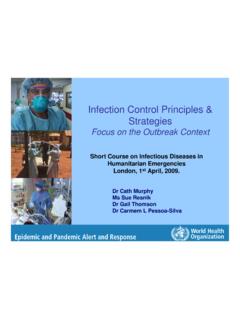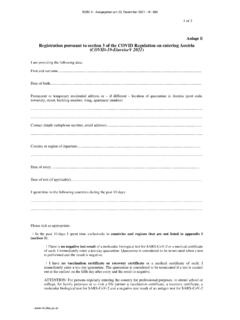Transcription of EMERGENCY & TRAUMA CARE TRAINING COURSE
1 EMERGENCY and Essential Surgical care (EESC) programme 1 | EMERGENCY & TRAUMA care TRAINING COURSE Basic TRAUMA , Anesthesia and Surgical Skills for Frontline health Providers Including management of injuries in women, children, elderly and humanitarian emergencies EMERGENCY & Essential Surgical care Clinical Procedures Unit Department of health Systems Policies & Workforce world health organization Geneva, Switzerland EMERGENCY and Essential Surgical care (EESC) programme 2 | INTRODUCTION Objectives: This COURSE is about managing TRAUMA , from minor injury to humanitarian emergencies , including injuries in women, children and the elderly, with the principal goal of improving quality of care and patient safety.
2 Introduction of instructors and participants Presentation of WHO Integrated Management for EMERGENCY and Essential Surgical care (IMEESC) toolkit [ ] EMERGENCY and Essential Surgical care (EESC) programme 3 | This is a compilation of all WHO documents relevant to EMERGENCY and TRAUMA care TRAINING COURSE Resources Integrated Management for EMERGENCY and Essential Surgical care (IMEESC) toolkit Surgical care at the District Hospital Pratique Chirurgicale de Base EMERGENCY and Essential Surgical care (EESC) programme 4 | Additional links to WHO Resources: 1. Guidelines for Essential TRAUMA care 2. Hospital care for Children 3. Integrated Management of Adult Illnesses, District Clinician Manual: Hospital care for Adolescents and Adults a) Quick Check and EMERGENCY treatments for adolescents and adults 4.
3 EMERGENCY Triage Assessment and Treatment 5. Guidelines on EMERGENCY health care 6. Integrated Management of Childhood Illnesses 7. Integrated Management of Pregnancy and Childbirth a) Managing Complication in Pregnancy and Childbirth: a guide for midwives and doctors b) Pregnancy, Childbirth, Postpartum and Newborn care : a guide for essential practice 8. Oxygen Therapy for Acute Respiratory Infections in Young Children in Developing Countries 9. Mass Casualty Management Systems 10. Prevention and Management of Wound infections 11. Safe Surgery 12. Patient Safety Pulse Oximetry Project 13. Tetanus Vaccination 14. Clinical Management of Rape Survivors 15.
4 Guidelines for Medico-legal care for Victims of Sexual Violence EMERGENCY and Essential Surgical care (EESC) programme 5 | MODULE 1 Principles and Techniques of TRAUMA care EMERGENCY and Essential Surgical care (EESC) programme 6 | OBJECTIVES OF MODULE 1 Learn basic techniques of triage and EMERGENCY care within the first, most critical hour, of a patient s arrival at the hospital Basic EMERGENCY resuscitation skills in adults and children open and maintain airway perform life-saving procedures manage active bleeding place intravenous lines learn shock management EMERGENCY and Essential Surgical care (EESC) programme 7 | SIX PHASES OF TRAUMA care MANAGEMENT Triage Primary Survey Resuscitation Secondary Survey Stabilization Transfer Definitive care Patient care timeline Phase I Phase II Phase III Phase IV Phase V Phase VI EMERGENCY and Essential Surgical care (EESC) programme 8 | MANAGEMENT GOALS Primary survey Examine, diagnose, treat life-threatening injuries as soon as they are diagnosed Use simplest treatment possible to stabilize patient s condition Secondary survey Perform complete, thorough patient examination to ensure no other injuries are missed EMERGENCY and Essential Surgical care (EESC)
5 Programme 9 | TRAUMA care MANAGEMENT Triage Primary Survey Resuscitation Phase I Phase II Secondary Survey Phase III Start resuscitation at the same time as performing primary survey Do not start secondary survey until completing primary survey Constantly reassess patient for response to treatment; if condition deteriorates, reassess ABC EMERGENCY and Essential Surgical care (EESC) programme 10 | TRAUMA care MANAGEMENT Do not start definitive treatment until secondary survey is completed unless required as life-saving measure When definitive treatment is not available, have a plan for safe transfer of patient to another centre Stabilization Transfer Definitive care Phase IV Phase V Phase VI EMERGENCY and Essential Surgical care (EESC) programme 11 | MAJOR TRAUMA TRAUMA mechanism: A fall >3 meters Road traffic accident.
6 Net speed >30 km/h Thrown from or trapped in a vehicle Pedestrian or cyclist hit by a car Unrestrained occupant of a vehicle Injury from high or low velocity weapon EMERGENCY and Essential Surgical care (EESC) programme 12 | MAJOR TRAUMA Physical findings: Airway or respiratory distress Blood pressure <100 mmHg Glasgow Coma Scale <13/15 Penetrating injury More than 1 area injured Make a full primary and secondary survey of any patient who is injured, especially if major TRAUMA EMERGENCY and Essential Surgical care (EESC) programme 13 | PHASE I: TRIAGE Triage: sorting and treating patients according to priority; identify, treat patients with life-threatening conditions first Priority may be determined by: Medical necessity Personnel skills Available equipment Vital signs Pulse rate Blood pressure Respiratory rate SpO2% Temperature AVPU (Alert, verbal, pain or unresponsive) Urine output EMERGENCY and Essential Surgical care (EESC) programme 14 | PHASE II: THE PRIMARY SURVEY Airway Breathing Circulation Disability or neurologic Damage Expose the patient Purpose is to identify and treat life threatening injuries.
7 Airway obstruction Breathing difficulties Severe external or internal haemorrhage EMERGENCY and Essential Surgical care (EESC) programme 15 | AIRWAY Always assess the airway Talk to the patient A patient speaking freely and clearly has an open airway Look and listen for signs of obstruction Snoring or gurgling Stridor or noisy breathing Foreign body or vomit in mouth If airway obstructed, open airway and clear obstruction EMERGENCY and Essential Surgical care (EESC) programme 16 | TECHNIQUES FOR OPENING THE AIRWAY No TRAUMA Position patient on firm surface Tilt the head Lift the chin to open the airway Remove foreign body if visible Clear secretions Give oxygen 5 L/min jaw thrust chin lift obstructed airway EMERGENCY and Essential Surgical care (EESC) programme 17 | TECHNIQUES FOR OPENING THE AIRWAY In case of TRAUMA Stabilize cervical spine Do not lift head!
8 Open airway using jaw thrust Remove foreign body if visible Clear secretions Give oxygen 5 L/min Modified jaw thrust EMERGENCY and Essential Surgical care (EESC) programme 18 | AIRWAY DEVICES Oropharyngeal airway Use if patient unconscious Use correct size - measure from front of ear to corner of mouth Slide airway over tongue If patient resists, gags or vomits, remove immediately! Nasopharyngeal airway Better tolerated if patient is semi-conscious Pass well lubricated into one nostril Direct posteriorly, towards the throat EMERGENCY and Essential Surgical care (EESC) programme 19 | AIRWAY Before attempting intubation the answer to these questions should be YES: Is there an indication?
9 -Failure to maintain or protect the airway (risk of aspiration) or -Failure to oxygenate or ventilate or -Impending airway failure (inhalation injury, angioedema) Do you have working equipment? -Functioning laryngoscope with working light -Appropriate endotracheal tube size -Bag-valve mask -Working oxygen source -Suction Do you have a post-intubation plan? -Is a mechanical ventilator available? (unless only short-term need) -Are sedative drugs available? EMERGENCY and Essential Surgical care (EESC) programme 20 | BREATHING Assess ventilation - Is the patient in respiratory distress? Look - For cyanosis, wounds, deformities, ecchymosis, amplitude, paradoxical movement Feel - Painful areas, abnormal movement Percuss - Dullness Listen - Reduced breath sounds EMERGENCY and Essential Surgical care (EESC) programme 21 | INDICATIONS FOR CHEST DECOMPRESSION Signs and Symptoms Absent or diminished breath sounds on one side Evidence of chest TRAUMA or rib fracture Open or "sucking" chest wound Diagnoses Pneumothorax Tension pneumothorax Hemothorax Hemo-pnemothorax EMERGENCY and Essential Surgical care (EESC)
10 Programme 22 | OPEN CHEST WOUND "Sucking" sound Requires very prompt treatment Apply an occlusive "plastic pack" dressing to wound, tape down on three sides, leaving one side open for air to escape Place a chest drain Never insert chest tube through wound Give high flow oxygen Give antibiotics Debride wound and consider closure EMERGENCY and Essential Surgical care (EESC) programme 23 | TENSION PNEUMOTHORAX Air from lung puncture enters pleural space, cannot escape Progressive increase in intrathoracic pressure causes mediastinal shift and hypotension due to reduced venous return Patient becomes short of breath and hypoxic Diminished breath sounds on side of pneumothorax Requires urgent needle decompression, then chest drain as soon as possible increasing intrapleural pressure compression of superior vena cava mediastinal shift compression of inferior Vena Cava EMERGENCY and Essential Surgical care (EESC)














